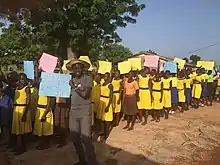همهپذیری (آموزش)
همهپذیری در آموزش به مدلی اشاره میکند که در آن دانشآموزان با نیازهای ویژه بیشتر یا تمام وقت خود را با دانشآموزانی که نیازهای ویژه ندارند (عموم دانشآموزان) میگذارند. مفهوم بنیادین این مدل از آموزش بر این اساس است که برای دانشآموزانی که نیازهای ویژه دارد موثرتر است که تجربه درس خواندن در کنار دانشآموزان معمولی را داشته باشند تا در رفتارهای اجتماعی خود بهتر عملکرده و در آینده زندگی بهتری داشته باشند. همهپذیری ایده مدارس استثنایی یا کلاسهایی که دانشآموزان با معلولیت را از دانشآموزان بدون معلولیت جدا میکند نمیپذیرد. مدارسی که بر پایه همهپذیری است کلاسهای جداگانه ندارند.

شیوه اجرای این شیوههای آموزشی در مدارس گوناگون متفاوت است. معمولاً مدارس از مدل همهپذیری برای دانشآموزانی استفاده میکنند که نیازهای ویژه متوسط تا اندک داشته باشند.[1] مدارس کاملاً فراگیر که نادر هستند بهطور کلی برنامههای «آموزش عمومی» و «آموزش ویژه» را جدا نمیکنند. در عوض ساختار آموزش به شکلی بازسازی شده که همه دانشآموزان بتوانند با همدیگر یاد بگیرند.[2]
جستارهای وابسته
منابع
- Allen, K.E. , Schwartz, I
- Scheyer et al. (1996). The Inclusive Classroom Teacher Created Materials, Inc. The Inclusive Classroom
برای مطالعهٔ بیشتر
- Baglieri, S. , & Shapiro, A. (2012). Disability Studies and the Inclusive Classroom. New York, NY: Routledge.
- Biklen, D.2000. Constructing inclusion: Lessons from critical, disability narratives.International Journal on Inclusive Education, 4(4):337 –353.
- Biklen, D. , & Burke, J. (2006). Presuming competence. Equity & Excellence in Education, 39, 166-175.
- Connor, D. (2006). Michael's Story: "I get into so much trouble just by walking":Narrative knowing and life at the intersections of learning disability, race, and class. Equity & Excellence in Education, 39, 154-165.
- Davis, L. J. (2010). Constructing normalcy. In L. J. Davis (Ed.), The Disability Studies Reader. (3rd ed.) (pp. 9–28). New York: Routledge.
- Erevelles, N. (2011). "Coming out Crip" in inclusive education. Teachers College Record, 113 (10). Retrieved from http://www.tcrecord.org Id Number: 16429
- Graham, L. , & Slee, R. (2007). An illusory interiority: Interrogating the discourse/s of inclusion. Educational Philosophy and Theory, 40, 277-293.
- Izquierdo, S.S. , Izquierdo, L.R. & López-Pintado, D. (2018). "Mixing and diffusion in a two-type population". Royal Society Open Science, 5(2) 172102.
- Kasa-Hendrickson, C. (2005) 'There's no way this kid's retarded': Teachers' optimistic constructions of students' ability. International Journal of Inclusive Education, 9 (1), 55-69.
- Kluth, P. 2003. "You're going to love this kid." Teaching students with autism in the inclusive classroom, Baltimore: Brookes.
- Knobloch, P. & Harootunian, B. (1989). A classroom is where difference is valued. (pp. 199–209). In: S. Stainback, W. Stainback, & Forest, M. , Educating All Students in the Mainstream of Regular Education. Baltimore, MD: Paul H. Brookes.
- O’Brien, L. (2006). Being bent over backward: A mother and teacher educator challenges the positioning of her daughter with disabilities. Disability Studies Quarterly, 26 (2).
- Porter, L. , & Smith, D. (Eds.) (2011). Exploring inclusive educational practices through professional inquiry. Boston, MA: Sense Publishers.
- Putnam, J. W. (1993). Cooperative Learning and Strategies for Inclusion: Celebrating Diversity in the Classroom. Baltimore, MD: Paul H. Brookes.
- Stainback, S. & Stainback, W. (1996). Inclusion: Guide for Educators. Baltimore, MD: Paul H. Brookes.
- Strully, J. & Strully, C. (1984, September). Shawntell & Tanya: A story of friendship. Exceptional Parent, 35-40.
- Thomas, G. (2012). A review of thinking and research about inclusive education policy, with suggestions for a new kind of inclusive thinking. British Educational Research Journal, 38 (3), 473-490.
- Thompson, B. , Wickham, D. , Shanks, P. , Wegner, J. , Ault, M. , Reinertson, B. & Guess, D. (nd, @1985). Expanding the circle of inclusion: Integrating young children with severe multiple disabilities into Montessori classrooms. Montessori Life.
- Toste, Jessica R.. “The Illusion of Inclusion: How We Are Failing Students with Learning Disabilities”, Oath Inc. (2015). Website.11(12)2017
- Wa Munyi, C. (2012). Past and present perceptions towards disability: A historical perspective. Disability Studies Quarterly, 32.
- Werts, M.G. , Wolery, M. , Snyder, E. & Caldwell, N. (1996). Teacher perceptions of the supports critical to the success of inclusion programs. TASH, 21(1): 9-21.